Lexus ES: Hybrid transmission
Select the shift position depending on your purpose and situation.
Shift position purpose and functions
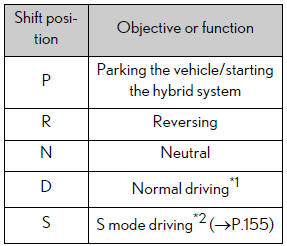
*1: To improve fuel efficiency and reduce
noise, set the shift lever in D for normal
driving. You can choose shift range suitable
for your driving situation by operating
the paddle shift switches.
*2: By selecting shift ranges using S mode,
you can control accelerating force and
engine braking forces.
■When driving with dynamic radar cruise control with full-speed range activated Even when performing the following actions with the intent of enabling engine braking, engine braking will not activate because dynamic radar cruise control with full speed range will not be canceled.
- While driving in the D position or S mode, downshifting to 5 or 4.
- When switching the driving mode to sport mode while driving in the D position.
■AI-SHIFT The AI-SHIFT automatically selects the suitable gear according to driver performance and driving conditions.
The AI-SHIFT automatically operates when the shift lever is in D. (Shifting the shift lever to S cancels the function.)
WARNING
■When driving on slippery road surfaces Do not accelerate or shift gears suddenly.
Sudden changes in engine braking may cause the vehicle to spin or skid, resulting in an accident.
NOTICE
■Hybrid battery (traction battery) charge If the shift lever is in N, the hybrid battery (traction battery) will not be charged even when the engine is running. Therefore, if the vehicle is left with the shift lever in N for a certain period of time, the hybrid battery (traction battery) will discharge, and this may result in the vehicle not being able to start.
Shifting the shift lever
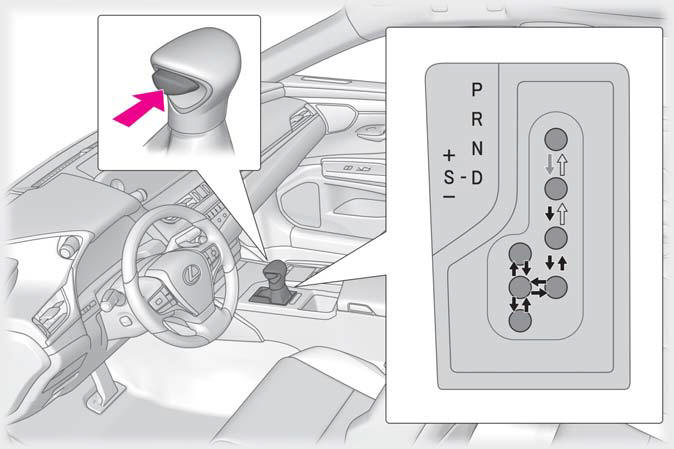
 While the power
switch is in ON mode and the brake pedal depressed*,
shift the shift lever while pushing the shift release button on the shift knob.
While the power
switch is in ON mode and the brake pedal depressed*,
shift the shift lever while pushing the shift release button on the shift knob.
 Shift the shift
lever while pushing the shift release button on the shift knob.
Shift the shift
lever while pushing the shift release button on the shift knob.
 Shift the shift
lever normally.
Shift the shift
lever normally.
When shifting the shift lever between P and D, make sure that the vehicle is completely stopped and the brake pedal is depressed.
*: For the vehicle be able to be shifted from P, the brake pedal must be depressed before the shift release button is pushed. If the shift release button is pushed first, the shift lock will not be released.
■Shift lock system The shift lock system is a system to prevent accidental operation of the shift lever in starting.
The shift lever can be shifted from P only when the power switch is in ON mode the brake pedal is depressed and the shift release button is pushed.
■If the shift lever cannot be shifted from P First, check whether the brake pedal is being depressed.
If the shift lever cannot be shifted even though the brake pedal is depressed and the shift release button is pushed, there may be a problem with the shift lock system.
Have the vehicle inspected by your Lexus dealer immediately.
The following steps may be used as an emergency measure to ensure that the shift lever can be shifted.
Releasing the shift lock:
1. If the parking brake is in manual mode, set the parking brake.
2. Turn the power switch off.
3. Depress the brake pedal.
4. Press down and release the cup holder lid to open.
5. Pry the cover up with a flathead screwdriver or equivalent tool.
To prevent damage to the cover, cover the tip of the screwdriver with a rag.
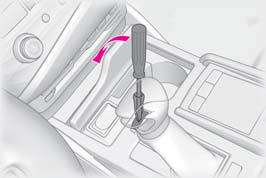
6. Press and hold the shift lock override button and then push the button on the shift knob.
The shift lever can be shifted while the button is pressed
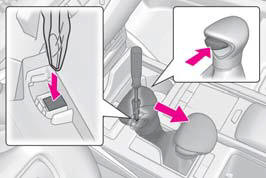
WARNING
■To prevent an accident when releasing the shift lock Before pressing the shift lock override button, make sure to set the parking brake and depress the brake pedal.
If the accelerator pedal is accidentally depressed instead of the brake pedal when the shift lock override button is pressed and the shift lever is shifted out of P, the vehicle may suddenly start, possibly leading to an accident resulting in death or serious injury.
Selecting shift ranges in the D position
To drive using temporary shift range selection, operate the "-" paddle shift switch. The shift range can then be selected by operating the "-" and "+" paddle shift switches.
Changing the shift range allows restriction of the highest shift range, preventing unnecessary upshifting and enabling the level of engine braking force to be selected.
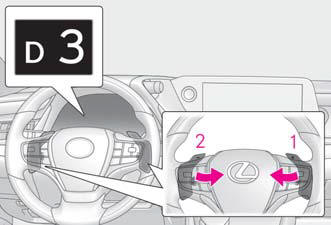
- Upshifting
- Downshifting
The selected shift range, from D1 to D6, will be displayed in the meter.
■When the "-" paddle shift switch is operated with the shift lever in the D position The shift range is downshifted to a range that enables engine braking force that is suitable to driving conditions.
■Automatic deactivation of shift range selection in the D position Shift range selection in the D position will be deactivated in the following situations:
- The "+" paddle shift switch is held down for a period of time
- When the vehicle comes to a stop
- If the accelerator pedal is depressed for more than a certain period of time
- When the shift lever is shifted to a position other than D
■Downshifting restriction warning buzzer To help ensure safety and driving performance, downshifting operation may sometimes be restricted. In some circumstances, downshifting may not be possible even when the shift lever or paddle shift switch is operated. (A buzzer will sound twice.)
Selecting shift ranges in S mode
To enter S mode, shift the shift lever to S. Shift ranges can be selected by operating the shift lever or paddle shift switches, allowing you to drive in the shift range of your choosing.
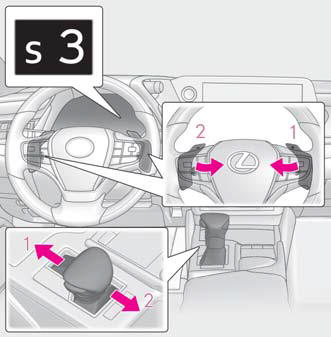
- Upshifting
- Downshifting
The selected shift range, from S1 to S6, will be displayed in the meter.
The initial shift range in S mode is set automatically to S5 or S4 according to vehicle's speed.
■ Shift ranges and their functions
- You can choose from 6 levels of accelerating force and engine braking force.
- A lower shift range will provide greater accelerating force and engine braking force than a higher shift range, and the engine revolutions will also increase.
- If you accelerate while in ranges 1 to 4, the shift range may automatically increase in accordance with the vehicle's speed.
■S mode
- When the shift range is S4 or lower, holding the shift lever toward "+" sets the shift range to S6.
- To prevent the engine from over-revving, upshifting may automatically occur.
■Downshifting restrictions warning buzzer To help ensure safety and driving performance, downshifting operation may sometimes be restricted. In some circumstances, downshifting may not be possible even when the shift lever or paddle shift switch is operated. (A buzzer will sound twice.)
■If the S indicator does not come on or the D indicator is displayed even after shifting the shift lever to S This may indicate a malfunction in the hybrid transmission system. Have the vehicle inspected by your Lexus dealer immediately.
(In this situation, the transmission will operate in the same manner as when the shift lever is in D.)
Turn signal lever
Operating instructions
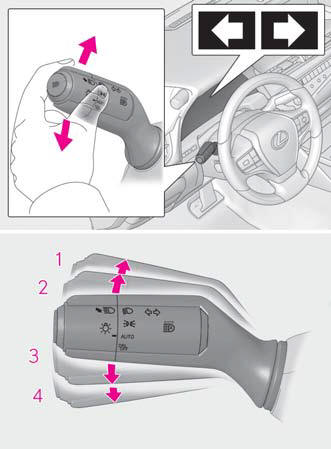
- Right turn
- Lane change to the right (move the
lever partway and release it)
The right hand signals will flash 3 times. - Lane change to the left (move the
lever partway and release it)
The left hand signals will flash 3 times. - Left turn
■Turn signals can be operated when The power switch is in ON mode.
■If the indicator flashes faster than usual Check that a light bulb in the front or rear turn signal lights has not burned out.
■If the turn signals stop flashing before a lane change has been performed Operate the lever again.

